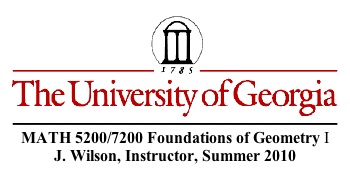

Problem Set 3.1
Problem 3.1.1a Open GSP file
Problem 3.1.1b Open GSP file
Problem 3.1.1c Open GSP File
Prove that the shaded figure is a square.
For a square, the diagonals are perpendicular and of equal length. Therefore the angles at D, K, H, and G are right angles.
Consider triangle CGL. It is an isosceles right triangle
Problem 3.1.3 Open GSP File
This derivation of the area formula for the trapezoid by this strategy is on page 5 of the GSP file.
Problem 3.1.4 a. Find the area of a rhombus in terms of its diagonals.
b. Will the formula you derived in Part a work for kites? Why or why not?
Yes, because the diagonals are perpendicular and the area can be dissected into four right triangles that can be rearranged into a rectangle that is a by b/2.
c. For which other quadrilaterals with the formula you derived in Part a work?
It will work for any quadrilateral with perpendicular diagonals.
Problem 3.1.5. The formula for the area of a triangle can be derived before the formula for the area of a parallelogram is proved. To do, use the suggestions in the following questions:
a. Using only the formula for the area of a rectangle, find the area of a right triangle with legs a and b.
b. Use your result from part (a) to derive the formula for the area of a triangle by using a sum or difference of the areas of right triangles. Open GSP File.
c. Use the formula for the area of a triangle to derive a formula for the area of a parallelogram.
Problem 3.1.6 In a trapezoid, the parallel sides are, respectively a and b in. long. The base angles are 45 degrees each. Find the simplest possible expression for the area of the trapezoid in terms of a and b (do not use trigonometry).
Problem 3.1.12 Open GSP File
Notice that the sum of the areas is the area of triangle ABC. This is equal to (1/2)(AC)(BC).
Problem 3.13. This is essentially Euclid's proof of the Pythagorean Theorem that is presented in Section 3.2.
Problem 3.1.14 Open GSP File
Be sure to animate the GSP file. The squares are congruent. The problem is to determine the ratio of the area of the overlap to the area of one of the squares. The corner of one square is placed at the center of the other.
There are several approaches. Since we are not given the lengths of any segments it is probably best to concentrate on showing congruent figures.
Useful lemma: A line through the center of a square divides the square into to two equal areas.
Construct a diagonal and show the two triangles formed by the square, the line, and the diagonal are congruent.
Problem 3.1.15
The two problem ask how to construct a line through point P in each drawing to divide the figure into two equal areas.
The second example gives one case of where the result (at least the lemma) from Problem 3.1.14 could be used to solve this problem. The four circles on the right fit into a square symmetrically and any line through the center of the square will divide the square into equal areas.
Problem 3.1.19. The problem shows a 'geometric' approach to finding a formula for the sum of the first n integers:
S = 1 + 2 + 3 + . . . + n. Two links are provided. One is to a write-up for the solution by Jackie Huff. The other is a more general discussion of the sum from the Situations Project.
Open GSP File Open another one
Problem 3.21.
Consider triangle ABC and complete the following
a. Prove that it is an isosceles right triangle
b. Find AC by finding the area of triangle ABC in two different ways (do not use the Pythagorean Theorem).